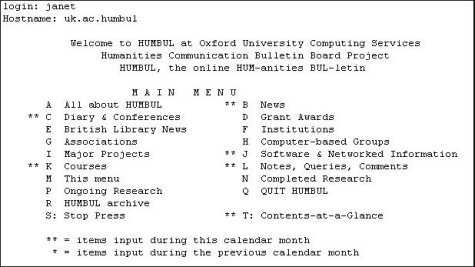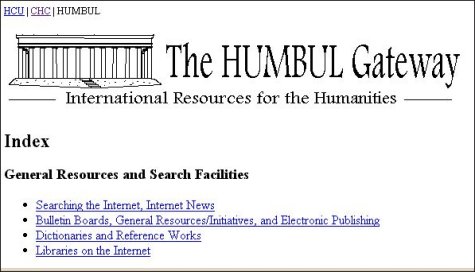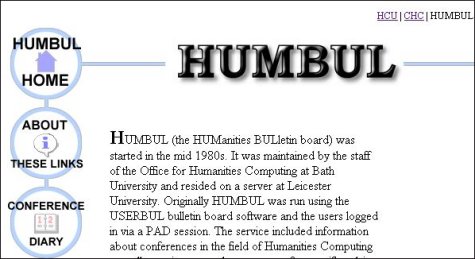 |
| Computers & Texts No. 15 |
Table of
Contents |
August 1997 |
Chris Stephens
University of Oxford
christopher.stephens@oucs.ox.ac.uk
HUMBUL (the HUManities BULletin board) was started in the mid 1980s. It was maintained by the staff of the Office for Humanities Computing at Bath University and resided on a server at Leicester University. Originally HUMBUL was run using the USERBUL bulletin board software and the users logged in to a text-only interface via a PAD session. The service included information about conferences in the field of Humanities Computing as well as pointers to other resources for specific subject areas. It was also a conduit for communication between humanities scholars interested in the possibilities of information technology.
 |
Fig. 1. The first HUMBUL: a simple text menu
With the advent of the World Wide Web HUMBUL, now residing on a server at Oxford University, was reformed as part of the Humanities Computing Unit Web site. Its role as a repository of links to Internet resources edged out many of its other functions. Communication was reduced to an email link to the HCU through which information about new or changed resources came in. The site itself, however, became little more than a rather unwieldy collection of links.
A major problem with both the earlier versions of HUMBUL was the effort involved in maintaining the currency of the information. The Web site in particular became very large. Keeping the links up-to-date, with the transitory nature of the Web and the volume of new material coming in, was a labour intensive and tedious task which meant that the upkeep was sporadic at best.
In its early Web incarnation HUMBUL also suffered from the static nature of HTML pages. The division of links into sections was fairly broad and each section contained a great many links with little room for anything more than the briefest description. Looking for a given idea could mean ploughing through a large volume of material, in several sections, with very little guidance about where a particular link would lead.
In order to try and rectify some of these shortcomings we have been involved for the last few months in developing HUMBUL with the objective of giving the users access to up-to-date and relevant information as well as making the task of maintenance a little less daunting. We also wanted to put back some of the original functionality. All information is now all held in a searchable database, implemented using the excellent Hughes Technologies mSQL database server. This allows users to carry out a keyword search, and, more importantly, to add information to the resource. The conference diary has reappeared, with 'This Week's Conferences' page at the top level. Users can add details of any conferences they may be involved with or report back on events they have attended. In the links section users will be encouraged to submit new links to the database and also to comment on any of the existing resources. These comments will form part of the searchable material. Maintenance has also been made easier and more efficient; all tables of information can be queried, added to and maintained through the appropriate Web form.
The subject specific sections will still form the backbone of the new version, but the links in database form are no longer tied to a particular section or page, and new sections can readily be added as the need arises. Storing the links as database fields also means that each link can be associated with further information about the link, such as a more detailed description of the linked site or user submitted comments. All the database information is searchable meaning that users can perform keyword searches across the site for a concept which might yield results from several sections, the submitted comments or the diary section. The search results appear as links to the relevant part of HUMBUL. Users are no longer constrained to a particular page or a particular subject, and can easily access information from several areas. Each of the section headings will also be linked to an essay, commissioned from a subject specialist, which is aimed at providing some orientation for the new user with advice about the best resources and some hints about the uses of the Internet in a particular field.
 |
Fig. 2. HUMBUL on the World Wide Web 1994-97
By allowing users to submit comments or links, the communication functions of HUMBUL are once again brought into play. It is hoped that people will use HUMBUL as a platform to express their views on the available resources, send feedback to the site designers, offer guidance to the fledgling Internet scholar, or submit new resources and conference details.
The site has been set up so that user's submissions go to a private database only accessible to the HUMBUL administrator. Submissions can then be reviewed before adding them to the publicly accessible database. Administrative functions are performed through a simple Web interface which is password-protected. Submissions are reviewed by calling them back into a Web form as editable fields, allowing rogue entries to be filtered out and the more garrulous submissions to be edited as necessary. Checking the currency of the existing links is achieved by a script which generates an HTML page consisting of all the links from all the sections. This page is then run through an automated link-checking package, such as URLegal, which will generate a list of the broken links it finds. Once the accuracy of this list has been verified the redundant links are removed from the database, again via a Web form in the admin directory.
 |
Fig. 3. HUMUL today: graphical and user-defined.
The ethos behind these improvements is a desire to move away from the static 'room' paradigm of most Web pages. By freeing the links and other information from any attachment to a specific section, and by making the entire resource searchable, it is hoped that the user will be presented with the information which is most relevant to them. This information could come, potentially, from several sections and could enable the user to access sections they might not have explored in the old static and divided HUMBUL architecture. This cross-pollination of resources will hopefully lead to a fertile exchange of views, through the comments section, between scholars from diverse disciplines.
There remains the knotty problem of CGI security to deal with before a full public release of the new HUMBUL site. This problem is being addressed at the time of writing, and the service should be available in the very near future. Updates will be published in Computers and Texts.
The current version of HUMBUL is available at http://info.ox.ac.uk/oucs/humanities/international.html
[Table of Contents] [Letter to the Editor]
Computers & Texts 15 (1997), p.23 Not to be republished in any form
without the author's permission.
HTML Author: Sarah Porter
Document
Created: 10 September 1997
Document Modified:
The
URL of this document is
http://info.ox.ac.uk/ctitext/publish/comtxt/ct15/stephens.html